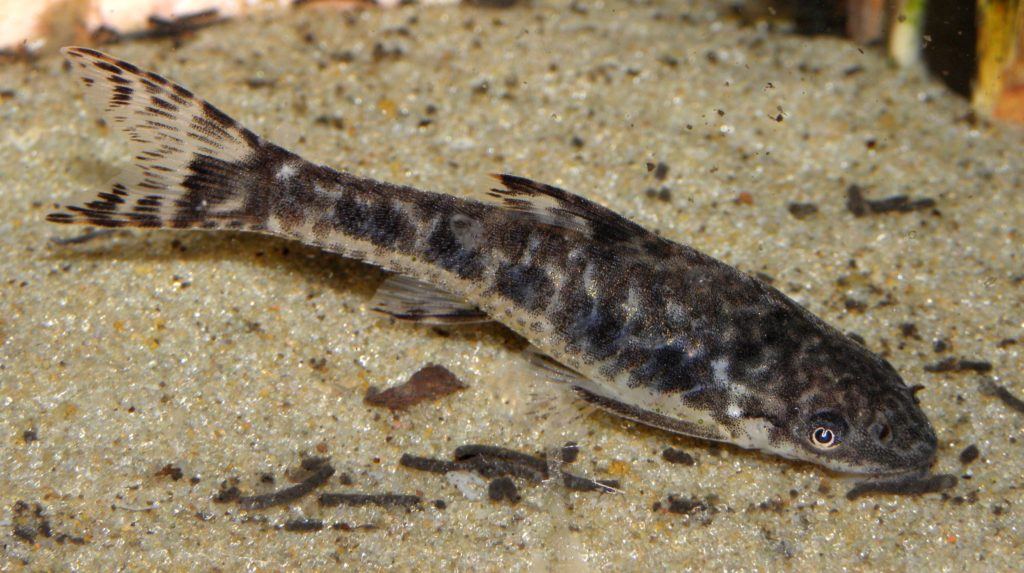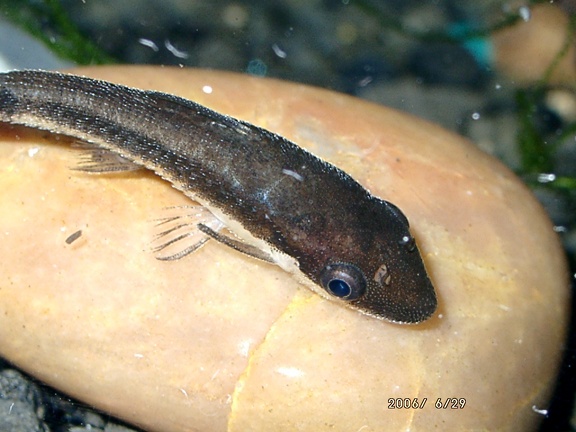The Otocinclus catfish has many alternative names and is also known as the oto catfish, as well as the dwarf sucker and the otto fish.
This genus of fish can most frequently be found in freshwater streams and cannot thrive in brackish or saltwater.

Oto catfish are also scavengers, though they are primarily herbivores, preferring to eat algae, and are purchased as aquarium tankmates to eat the algae which grow in the substrate of the tank.
Contents
Getting to Know the Otocinclus Catfish
Personality
Otos tend to cling to their tanks’ substrates, though they do have the ability to surface from under the water and breathe air.
The otto fish is exceptionally difficult to breed in captivity, so while there are a number of oto catfish currently kept in aquariums, in order for owners to invite new fish into their tanks, said fish must be taken in from the wild.
The otto’s delicate immune system also factors into their relatively small captive population; any aquarium that houses an otto needs to be carefully monitored for appropriate nitrate and ammonia concentrations.
Otocinclus catfish, on a more straightforward level, make intriguing additions to any tank that’s been suitably designed for them. They are narrow fish and are usually quite small, so long as they haven’t been overfed.
Appearance
Their coloring resembles that of a tabby cat – speckled brown and black, so that they can better blend into the substrates of the streams they would inhabit in the wild.
These fish are also exceptionally quick, when they choose to detach themselves from their substrates, so get a good look at them while they’re holding still!
Don’t get freaked out by their mouths, either. In order to eat the algae that they enjoy so much, they have mouths that form tight circles, allowing them to suck at any surface they attach to with a ferocity that stands in stark contrast to their diminutive size.
Overall Basic Statistics
It’s not necessary to understand the biology of the otto fish in order to bring one into your home aquarium, but it is important to keep the fish’s needs in mind.
If you don’t do a bit of research to prepare yourself for the care and keeping of your otocinclus catfish, it’s possible that you could inadvertently shorten the fish’s lifespan.

Instead, be smart about your fish care and set up your otto’s aquarium with the intent to provide an environment in which your otto can live and thrive.
Keep some of the following details in mind, too, before deciding whether or not an otto fish is the right type of fish for you:
- Size: 1.5 to 2 inches.
- Water Temperature: 72 to 79 degrees.
- pH: 6.8 to 7.5.
- Lighting: Standard.
- Lifespan: 3-5 years.
- Allergies: No ammonia or nitrates.
Natural Habitat
Wild otto catfish are primarily found in freshwater streams in South America, though they’ve also been known to make their homes in the shallower parts of the continent’s rivers.
Much like they do in captivity, the otto catfish attach themselves to available plant life both to feed and to maintain their position within a body of water.
So long as they’ve chosen strategically, they can avoid a number of larger predators – though this is made more difficult by their preference for staying towards the surface of the body of water they choose to inhabit.
Their speed helps them make up for this urge, as their slimness and quickness help them evade whatever critters may try and eat them on a day to day basis.
So long as the water around them moves a little more slowly and is bubbly with oxygen, the otto catfish are content to live out their lives in the temperate, freshwater of the continent, enjoying as much algae as they can get their mouths on.
Otocinclus Catfish Care
Tank Requirements
Consider the algae, then, not only as a source of food for your ottos but as an element of their ideal tank habitat.

In order to ensure that your Otocinclus care is up to snuff, you’re going to want to ensure that your tank has been cleaned well and that it contains a number of hard surfaces on which algae can grow.
The tank should be, at a minimum, twenty gallons in size, with the size increasing by ten gallons for every additional fish you intend to house. You should be able to leave a sliver of air at the top of the tank, as well, so your ottos can surface, should they wish to.
The otto’s ability to breathe air makes it one of a select group among its fishy brethren, but it also makes it an even better tankmate to snails who need access to land or oxygen on a regular basis.
You’ll also want to fill your tank with an appropriate amount of plant-like stimuli for your otto catfish to enjoy. These catfish may enjoy slow moving water, but they appreciate an environment that they can play in, as well.
Live plants are perfectly acceptable tank accessories, so long as they don’t introduce any unhealthy chemical elements into the tank water.
Be sure you buy a pretty impressive filter when creating the ideal habitat for your ottos – they won’t respond well to the presence of ammonia or nitrates in the water.
Feeding Otocinclus Catfish
As has been previously mentioned, otto catfish prefer, and even enjoy, to eat the algae that grow on the inside of their tanks.

Softer and greener algae tends to go over well, and provides the ottos with the appropriate amount of nutrients, but brown diatom algae is also an acceptable treat for your fishy friends.
If you’re concerned that your ottos may not be getting enough to eat, though, there are alternatives available to you.
Zucchini slices and spinach both serve as excellent substitutes for the algae your ottos may be missing out on.
These fish may be slow to eat any vegetation you leave in their tank for them, though, so it’s possible you’ll have to fish out the remnants of your ottos’ dinner a day after you placed them into the tank.
Whatever you choose to feed your ottos, you’ll want to ensure that it’s a type of vegetation that also provides them with a reasonable amount of protein.
Otocinclus CatfishTemperament and Tankmates
Otocinclus catfish are a generally peaceful type of fish, though perhaps more out of necessity than anything else.
These fish do not have any real means of protecting themselves or of attacking other kinds of fish that would serve as prey or competition for territory.
As such, the otto makes an excellent tankmate to a number of equally mild types of fish, though certain snails or shrimp also make welcomed companions. Cory catfish also make fantastic companions in the otto’s preferred schools.
Speaking of which: the ottos do prefer to move in schools, which means you may want to get a number of them for your tank.
This, of course, may mean bringing some in from the wild, but the ottos should still be friendly, if a little shy upon their introduction to any other fish you may have in your tank.
The ottos will move as a school while searching for food, and generally seem to enjoy the companionship of other members of their species, so do what you can to ensure that their social needs are met.
No matter what, though, you should not house your ottos with goldfish, cichlids of any subspecies, or oscars. All three of these types of fish are especially aggressive, and because the ottos have no manner of teeth or aggressive tendencies with which they could protect themselves, they are effectively ideal prey.
You will reduce your ottos’ stress levels by pairing them with more mild-mannered tankmates.
If you’re looking for live prey for goldfish, cichlids, or oscars, do yourself a favor and purchase creatures already intended for consumption; your ottos can exist peacefully, and your predatory critters can chase a more appropriate meal to their hearts’ content.

Breeding
It is notably difficult for ottos to breed in captivity, but that doesn’t mean that it’s impossible.
Breeding ottos does take a concentrated amount of time, however, so much so that, should you find yourself interested in breeding your ottos, you’ll want to move them out of a community tank and into a specified breeding tank with their school.
Otocinclus catfish have a notable courtship period in which they dance around one another, familiarizing themselves with potential mates. Once that period ends, the female otocinclus lays her eggs.
The male most often has to hover over her in a T-position in order to properly fertilize the eggs. If the positioning is successful, then you may well find yourself with otocinclus catfish fry after an appropriate incubation period.
It is worth noting, though, that neither the male nor female otto will be especially protective of these fry. Unlike other catfish, ottos do not create nests for their young, nor do they defend them.
This may be because of their relatively passive natures, but it primarily means that it will be best for you to keep the otocinclus catfish fry out of a community tank until they’ve matured.
Diseases
Because your ottos have a particularly delicate immune system, you should take care to watch for any symptoms of their failing health.
A reduced appetite, lethargy, heavy breathing, or general inactivity can all serve as warning signs that your ottos have some sort of issue with their health.
First of all, check the perimeters of your tanks and ensure that the chemical levels are where they should be. If the habitat proves to be suitable, then you may want to monitor your ottos for fungal or parasitic infections.
Here’s a video showing more about Otocinclus Catfish care.
Do you have any tips for Oto catfish care?

